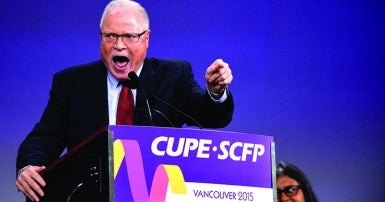Janet Szliske | CUPE Communications
Lee Saunders is president of the American Federation of State, County and Municipal Employees (AFSCME). AFSCME represents 1.6 million members from almost every state in the U.S. Saunders spoke with Counterpoint after delivering a fiery speech at CUPE’s National Convention.
What would you say to union activists who may get discouraged because of attacks against the labour movement?
Well, I would just urge that we can’t get discouraged. They want us to get discouraged. They want us to get frustrated and we’ve just got to stand up together. We’ve got to come together like never before because these attacks are vicious. They want us gone and it’s up to us to stand up. To stand up for public services. To stand up for working families, those who are in unions, those who are not in unions. To stand up for an economy that works for all. To give people a fair shot to achieve that dream to have a better life.
The numbers on how AFSCME has grown are phenomenal. How do you actually talk to your members?
You’ve got to change the way that the union is doing business essentially. You’ve got to devote resources and staff time to talk with members. And just as important, we’ve got to engage our members to talk to their co-workers. We do that through training programs, like our volunteer member-organizing program where we are training people to talk. We want to train 8,000 folks so that they can talk to their co-workers across the country. Our affiliates are completely engaged in this effort, but you must have the engagement of your activists and you’ve got to have the engagement of members to pick up the ball and to talk to folks. That’s the only way we’re going to get it done.
What can a local do to build collective action?
The first thing you have to do is engage members and talk with them so that they are involved, so they are the union. The union is the strength of its members and the actions that are taken by its members. So you’ve got to identify the issues those members are confronted with at the local level, what are they concerned about, the attacks they are under and then you develop a plan. You develop a strategy and you talk to folks asking them to be involved and asking them to come together for their own sake, for their livelihood, for their family’s livelihood, for their community’s livelihood. I cannot say enough about the importance of having that basic one-on-one communication. I think that we have kind of dropped the ball in the past where we have stopped talking because of all the new technology. We’ve stopped talking to people. Nothing takes the place of talking to folks.
How do you encourage members to be strong, to be active, to get involved?
The first thing is that I listen to them. I don’t think in these conversations you say we want you to do this and we want you to do that, because these folks in many cases have not been talked to before. Seeing where their interests are, seeing where their frustrations are and then you talk about how you resolve those things.




